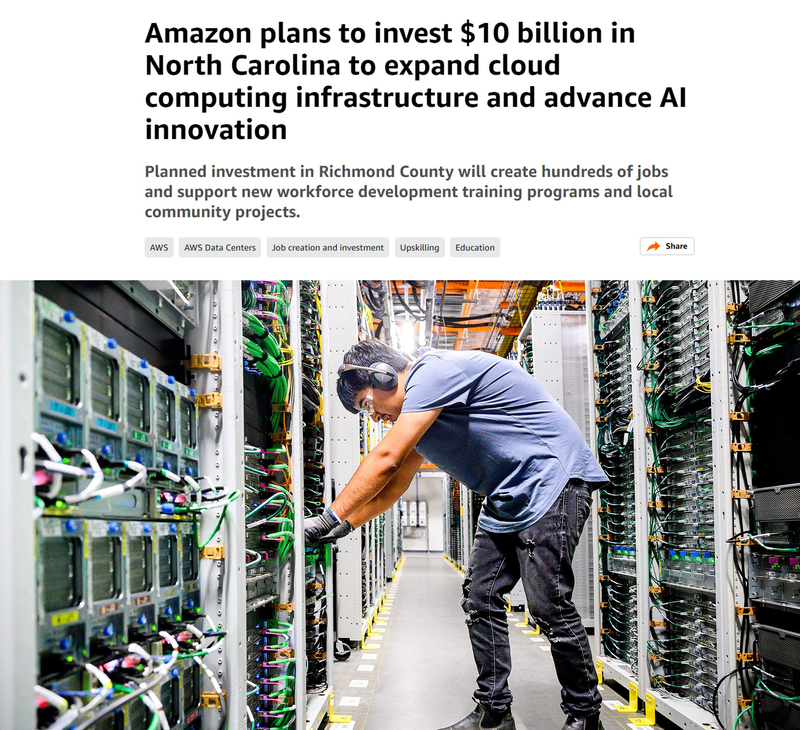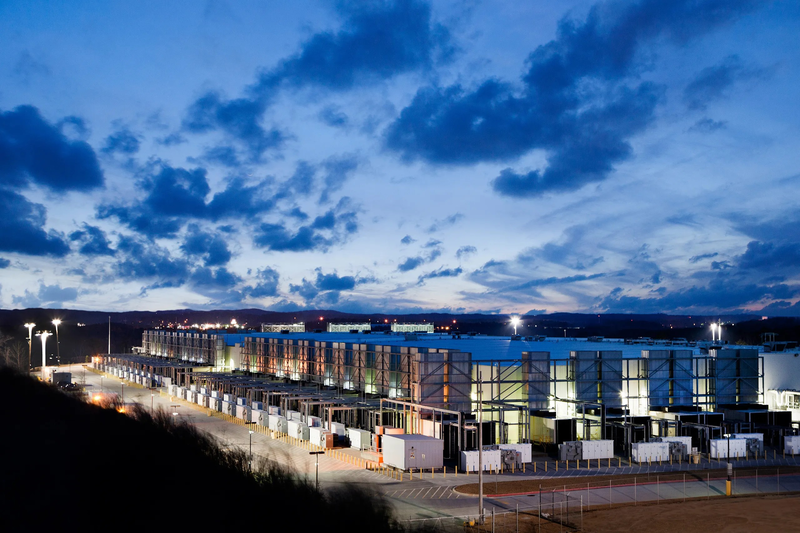Amazon to Invest $10 Billion in North Carolina Data Center, Accelerates AI Infrastructure Expansion
Input
Modified
Amazon Announced USD 11 Billion Investment in Georgia in January Google, Microsoft, and Meta Also Expanding Investments in AI Infrastructure Big Tech Races to Secure AI Dominance by Expanding Data Centers

As artificial intelligence (AI) rapidly evolves into the defining technology of our era, Big Tech is racing not just to innovate but to dominate the physical foundations of the AI revolution. Central to this race are data centers—massive, power-hungry facilities packed with high-performance computing hardware that have emerged as the linchpins of AI speed, quality, and competitiveness. In this context, Amazon’s newly announced USD 10 billion investment in a state-of-the-art data center in North Carolina marks more than just another corporate expansion. It signals a deepening arms race in AI infrastructure, where the winners may well define the future of the global digital economy.
Amazon CEO: “Generative AI Is a Once-in-a-Lifetime Opportunity”
On June 4, Amazon announced a major expansion of its AI infrastructure with a USD 10 billion investment to construct a new data center in North Carolina, operated under Amazon Web Services (AWS). The announcement was framed as part of Amazon’s strategy to meet soaring demand for cloud infrastructure and computing power, driven in large part by the rapid rise of generative AI technologies. According to the company’s official blog post, the project will not only support Amazon’s long-term AI ambitions but also generate approximately 500 local jobs, bringing economic and technological benefits to the region.
This investment is a key part of Amazon’s larger plan to spend up to USD 100 billion in capital expenditures this year, with a majority of the funds channeled into AI-related projects. Earlier this year, Amazon revealed another substantial plan: a minimum USD 11 billion investment in a new data center complex in Georgia, its largest single capital investment to date. Since 2010, Amazon has invested a total of USD 18.5 billion in Georgia, and this latest initiative is focused heavily on AI-specialized infrastructure, including proprietary AI chips, high-performance servers, and advanced network architectures.
Amazon CEO Andy Jassy has emerged as a vocal champion of the company’s AI ambitions. “Generative AI is a once-in-a-lifetime opportunity,” he declared earlier this year, underscoring Amazon’s strategy to lead in both foundational technology and applications. In line with this vision, Amazon has already launched several AI initiatives: it introduced "Alexa+", a reengineered version of its voice assistant powered by generative AI; unveiled a new AI agent called “Nova Act”, capable of autonomously performing complex user tasks; and rolled out its own large language model (LLM) along with Trainium, a self-developed AI training chip.
Amazon’s external partnerships are equally bold. The company has invested USD 8 billion in Anthropic, the AI startup behind the Claude chatbot, a move widely seen as a bid to diversify and strengthen its foothold in the AI ecosystem. From chip development to model deployment, Amazon is positioning itself not merely as a user of AI, but as one of its chief architects.
Microsoft, Alphabet, and Meta Ignite a Multi-Billion Dollar Infrastructure Race
Amazon’s strategic investments are part of a broader trend among the "Big Four" U.S. tech companies—Amazon, Microsoft, Alphabet, and Meta—all of whom are ramping up spending on AI data centers at an unprecedented scale. While 2023 saw some caution due to fears of an AI infrastructure bubble, the strong Q1 earnings in 2025, especially in AI and cloud segments, have reignited full-speed capital deployment.
Microsoft, which had previously signaled a possible reassessment of its data center plans, reversed course this year after reporting a 33% year-on-year increase in revenue from Azure, its cloud computing platform. During its earnings call, the company announced a monumental USD 80 billion commitment to AI infrastructure development, making it one of the largest such investments in the industry’s history.
Alphabet, the parent company of Google, is also charging forward. It has allocated USD 75 billion for AI infrastructure in 2024 alone, more than double its 2023 investment of USD 32.3 billion. CEO Sundar Pichai emphasized that the spending would reinforce AI capabilities across Google’s entire portfolio, including its flagship services, Google Cloud, and DeepMind. Alphabet CFO Anat Ashkenazi added that most of this capital will be devoted to expanding data centers, server infrastructure, and networking systems tailored to AI workloads.
Meta, too, has significantly raised its game. Riding a 16% increase in revenue and a 35% rise in earnings per share (EPS) in Q1, Meta revised its AI infrastructure spending plans upward by about 40%—from an initial estimate of USD 60–65 billion to a new range of USD 64–72 billion. These funds will be invested in building new data centers, recruiting top AI talent, and securing AI semiconductors, crucial for running large-scale models. CEO Mark Zuckerberg projected that “2025 will be a decisive year for AI”, outlining a vision in which Meta’s AI assistant will serve more than 1 billion users as a daily tool.
Together, these announcements represent the largest wave of AI infrastructure investment in tech history. They also mark a strategic turning point: no longer content to rent computing power, Big Tech is building the future—literally—from the ground up.

AI Data Centers as the New Strategic Battlefield
At the core of this global infrastructure race lies a clear motive: to control the performance, scalability, and sovereignty of AI services. For Big Tech, data centers are no longer peripheral assets. They are the essential engines that power AI models capable of understanding language, generating images and video, and automating complex tasks in real time.
Generative AI’s insatiable need for real-time processing of large datasets makes proximity to users and computational power non-negotiable. If a data center is located too far away, or lacks sufficient capacity, latency issues arise, degrading the speed and quality of AI-driven applications. This is why the leading tech companies are no longer outsourcing this infrastructure—they are building and owning it, ensuring tighter integration, reduced latency, and greater control over mission-critical services.
Moreover, these data centers are vital to maintaining technological independence. Training next-generation models like large language models (LLMs) requires access to vast clusters of GPUs, custom AI chips, and robust networking frameworks—resources that cannot be left to third-party providers. Companies like Amazon and Microsoft are now investing billions to design and operate AI-specific data centers that give them full-stack autonomy—from chip architecture to application layer.
The urgency is magnified by an emerging capacity crunch. The supply of data center space is failing to keep pace with the explosion in AI adoption. In major tech markets like the United States, vacancy rates in data centers have plummeted to just 1–2%, creating bottlenecks that threaten to slow innovation. Against this backdrop, the ability to own and scale infrastructure internally has become not only a financial advantage but a strategic necessity.
By building their own data centers, companies can cut long-term costs, reduce operational risk, and control their growth trajectory. In a world where compute power is the new oil, these facilities have become the battleground for technological supremacy.





















